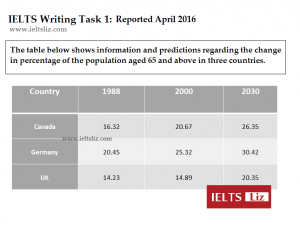The IELTS table below shows information with both past and future predictions. This IELTS writing task 1 table appeared in the exam recently and has been reproduced as accurately as possible with data provided by a student called Oyon (April 16th). This table is the IELTS academic writing test.
I will post a model answer for the table below next week.
If you want to try this task 1 table with future predictions, please post your writing in the comments box below. However, I am not currently available to comment on your writing. This will solely be for the purpose of practice and to compare with my model when it is published.
IELTS Table with Future Predictions
Useful Links for Writing Task 1
- Practice Charts for IELTS Writing Task 1
- Model Answers and Tips for IELTS Writing Task 1
- How to Describe a Bar Chart: Free Video Lesson
- IELTS Table Model Answer
- Overview or Conclusion: Free Video Lesson
Main IELTS Pages
Develop your IELTS skills with tips, lessons, free videos and more.









The table illustrates the percentage of the population between the age of 65 and above in 1988 and 2000 and a forecast of what the percentage will be by 2030 in three different countries(Canada,Germany and UK). Units are measured in percentage.
Overall, there was a significant rise in the percentage of the population aged 65 and above in Canada and Germany in the second year in contrast to the UK who had only a minimal change. Likewise, there will also be a significant increase in the population aged 65 and above by 2030 in all the three countries. Furthermore,the percentage of the population aged 65 and above was and will be highest in the future in Germany as opposed to the percentage in the UK which was and will be the least in the future.
In 1988, 20.45% of the population of Germany was 65 years and above compared to Canada and UK(16.32% and 14.23% respectively). While there was an approximately 5% increase in the population aged 65 and above in both Canada and Germany in 2000, in the UK there was only a mere 0.66% rise.
In the future, it is believed that the population aged 65 and above will climb to 30.42% in Germany by the year 2030, likewise will it grow to 26.35% and 20.35% in the same year in Canada and the UK respectively.
thanks for your useful system
Thanks for great sharing post its very useful for everyone
Thank you Liz, you are indeed a teacher. You know how to pass information to students. Your online teaching materials has helped me a lot.
Big Hugs
Paul,
The table gives information and forecast about the growing population between aged 65 and above in the Canada, in the Germany and in the UK.
Overall, it is clearly evident that there was an steady increase of population percentage aged 65 and up in three different nations in the period given, although there was a negligible number can be seen for the first 2 years in the UK.
To be specific, elder people in the Canada and Germany, of aged 65 and above had increased at around 5% between 1988 and 2000, as opposed by British elderly which had a negligible number less than 1% only, however, in the year 2030, it rose of about 5% respectively. Similarly, both Canada and Germany increased steadily, approximately at 5% ,which is almost the same in the first 2 years of predictions.
The table compares the proportion of ageing population in Canada,Germany and the UK from 1988 to 2030.Overall ,it can be seen that there is a rising trend in proportion of elderly people in all three countries with same trend continuing into the future.
To begin ,in 1988,Germany had the highest elderly population,at around 20%, followed by Canada nearly around 16%. Meanwhile,at the begining the UK had relatively lower number of elderly, which stood at 14% of population. By 2000, proportion of people aged 65 and more had risen approximately by 5% in Canada and Germany while the rise was minimum in the UK.
Moving on to future predictions,Germany and Canada are likely to have nearly 10% higher figures than at the begining in 2030. In fact,in this year just under third of German population is likely to be aged 65 and over,and around quarter of Canadian population expected to be at this age. In comparison,nearly one fifth of UK population is likelely to reach this age category.
The table illustrates data and predictions of variation of percentage of elders who aged 65 and over in three countries (Canada,German,UK). Percentage of variation considered in year 1988,2000 and 2030.
Overall,UK was the least variation of percentage of elders over aged 65 while German was the highest.The maximum assumed variation of percentage of elders over age 65 will be German when UK will be the least.
In 1988 and 2000,UK was the least variation of percentage which is 14.23% and 14.89 respectively.German was the highest variation,In 1988 it was 20.45% and 25.32% in year 2000 .In Canada,1988 Elders percentage variation was 16.32 it was rise up to 20.67% in year 2000.
In year 2030,it’s assumed the variation in percentage of elders over age 65 in three countries(Canada,German,UK) will be 26.35,30.42 and 20.45 respectively.German will be assumed the highest variation in percentage among these three countries in these considerable years.
This table illustrates the variations in population rate among elders in previous years (1988 and 2000) and in the upcoming year (2030)for specific countries that are Canada, Germany and U.K. Germany was a step ahead among these three countries and expected to remain ahead in the year 2030.
In 1988,Germany had high survival rate 20.45% as compared to Canada and U.K .i.e was 16.32 and 14.23% approximately.In 2000 ,Germany still maintained its high position by 5% of Canada(20.67%) and almost a double rate of U.K. population (14.89%)
By 2030,it is assumed that percentage of living years by older people would be continued to rise from previous years . In U.K. rate increase only by a rise in 6% from 1988 while in Canada and Germany,rate rocketed to 10% from 1988. Therefore ,U.K. is improving at a steady pace as compared to other two countries.
Overall, the trend for living population of elders is continued to rise constantly from previous two decades and predicted to be same in the forthcoming year 2030.Furthermore,by reviewing data, Germany will sustain its high position and Canada at second and U.K. at last position.
The table depicts information and prediction related to the change in the percentage of the number of people aged 65 and above in Canada, Germany and UK in four decades.
According to the data provided, Germany has 20.45% of old aged people in 1988 which is increased to 25.32% in 2000 and is predicted to 30.42% in 2030, which is highest of all.
While, Canada has 4% increase in 12 years since 1988, and reached 20.67% in 2000. The change is predicted even higher of 6% and will reach 26.35% in the year 2030.
At the same time, UK lowest among three countries. UK sees 14.23% of old aged people in 1988 and has less than 1% of increase till 2000. But, by 2030, UK will have 6% of growth in this age group and eventually reach 20.35%.
The chart shows the changes in the ages of population 65 and above in canada,germany and Uk over a period of 5 decades.It can clearly be seen that by 2030 Germany will have highest proportion of elderly peoples.
In 1998,both Canada nad UK had alsmost the same the proportion of aged population while GErmany was bit higher in percentage being 20.45%.
After a decade Canada showed huge increase in popualtion percentage to 20.67% while Germany also had considerable increase whereas Uk it showed negligible increase in aged population from 14.23% to 14.89%
But in 2030 it is predicted that UK be will showing huge increase in eaderly population of 20.35% while there will be linear increases in eaderly popul;ation in both GErmany and Canada.
To conculude,it can be predicted that UK will have least increase in ederly population of all 3 countries whereas Germany will have linear increase over period of time
The table illustrated the proportion of population aged 65 in the three different countries, Canada, Germany and UK in the period of 13 years from 1988 to 2000 and the prediction to the year 2030.
In 1988, the population of Germany are the highest with 20.45 and follow by Canada, 16.32 and UK, 14.23 which each countries increased around 6% up to year 2000. In term of prediction, it is expected that the Germany is reached to 30.42 which is the highest population while the Canada has 26.35 follow by UK 20.35 in the year 2030.
The table illustrates the proportion of people over 65 from Canada, Germany and the UK in 1988 and 2000, including future predictions for 2030.
Overall, it can be seen that the proportion of older population showed a rising trend and it will continue to rise in the future in all three nations. It is also worth noting that Germany had and will have the largest percentage of the 65-year old among these countries.
Looking into details, by 1988, the aged citizens in Germany and Canada were 20.45% and 16.32% respectively. 12 years later in 2000, both countries experienced a rise of approximately 5% . However, in the UK, where the percentage of old citizens was the least in 1988, only a minimal rise from 14.23% to 14.89% could be seen over the same period.
Regarding future predictions, the figure for Germany will still increase as much as 30.42% by the year 2030, which is around one-third of its population. Likewise, Canada is estimated to encounter a further 6% rise to end the period at 26.35%. Similarly, despite initial slow rise, about 1 in 5 UK citizens will be 65 years and above in 2030.
Thank you so much Liz. You must be an angel.
the table reveals the change in proportion of people living in three different countries aged 65 years old in two year 1988, 2000 and predicted in 2030.
overall, Germany has been the most populous than Canada and UK in these years. These countries had increased population from 1988 to 2000 and forecast to still rise in 2030. of three nations, population of UK has been the least.
In 1988, the most populous countries was Germany with 20.45 millions as compared to 16.32 millions of Canada and 14.32 millions of UK. In 2000, people lived in Germany rose the most by near 5 millions and total Canadian approached by above 4 millions. The population of the United Kingdom raise the least, at by only 0.5 million.
In 2030, Germany was predicted to be still the most populous nation, at above 30 millions. Similarly, the trend of Canada will go up and reach to 26.35 millions. Figure for UK will rise with the most rapid growth, by over 6 million of population.
The table illustrates the proportion of the population who are aged 65 and above in three countries (Canada, Germany and the UK). The figures are compared from past and also includes information with future estimation on these population group.
Overall, these age group is predicted to have a gradual increase in their percentage in all the three countries. It is clear from the given data that, in Germany, the population of aged people who are 65 and above are higher compared to Canada and the UK in all the periods given and estimated to be the same in the future.
During 1988 and 2000, the figures of this population group (65 and above) in Germany and Canada accounted for 20.45% and 16.32% respectively and increased by around 5% in 2000. Surprisingly, there was only minimal change over this decade in this age group in the United Kingdom at about less than 1%.
Furthermore, it is projected that, by 2030, the amount of people aged 65 and above will rise steadily for about 5% in all these three countries. Among these countries population with the age 65 and plus, Germans predicted to be at the top at 30.42% followed by Canadians (26.35%) and at the last Britons (20.35%).
thank you so much madam. i love your program so much.
Do we need any conclusion statement in Task 1?
No need
Thank you so much madam.
I think we can add more things to this table that people in past were not as much awair to health concern and did not have leasure time to take care of their health.nowadays, people do yoga,arobics and gym to keep their body fit.In future, people will give more attention to there health to cure theirself.
The level of medicine has increased substantially, so people in western countries (Canada, Germany and UK obviously belong to the list) live longer now then they used to – less stressed life and diverse food consumption has led to a longer life in the countries But that is not the biggest concern! The biggest one is that in a couple of decades people will be having more advanced medicine, and probably will live even longer then now.The second one is the Asian and South Asian region,which middle class grows gradually. The vast majority of such countries as India and China is still living in poor conditions and have no proper medical services. But observers say that the level of econimics of these countries are growing constantly and it’s hard to imagine what awaits our planet if people in Asia would live longer. The growing middle-class itself is a concern as they already are facing the lack of fresh water and natural resources in that region. The proper health service would lead the countries to even bigger population and accordingly to less and less natural stocks. The only solution I can see now is to stop growing population and regulate childbirth.
The table gives information in relation to the ageing population in Canada, Germany and Britain in three different times.
Overall, in all countries, the proportion of people aged 65 or more increased and will continue to rise over the period shown. Germany had the highest percentage of older population, and the same is predicted for the year 2030 while the least proportion can be seen in the UK in the same period.
In 1988, the proportion of elderlies was higher in Germany (20.45%), while the figures were comparatively lower in both Canada (16.32%) and England (14.23%), but quite similar percentages. By 2000 a steady increase in the proportion of older population could be seen in both Canada and Germany, rising by around 4%, at 20.67% and 25.32% respectively, whilst the rise in the UK was marginal.
By 2030, the ageing population is predicted to increase, with a noticable growth of approximately 5% in all three countries. Germany is expected to have the highest rate of 30.42%, followed by Canada(26.25%) and the UK (20.35%).
very nice indeed
i like how you presented it..it was brief and clear
Good structuring. I have been working for such type of construction of task for ages ,which is not in my way. do you have any tip for me to improve my essay?
The table provides information with prediction of the perecentage of the population aged 65 and above in three countries (Canada, Germany and UK?
Overall,there was significant change in population aged 65 and above in Canada and Germany between 1988 and 2000. Wherease, the lowest change was in Uk in the same period given.
In term of prediction, it is expected that the three countries would have been the same percentage change in population by about 6% in 2030.
In Canada, the percentage population of 65 aged increased from 16.32% to 20.67 (by 4%) between 1988 and 200. Similarly, in Germany the change was approximately the same (5%) compared to UK which the change was the lowest (less than 1%).
In 2030, the highest percentage of the people aged 65 and above will be in Germany at 30.42% followed by Canada then Uk at 26.35 % and 20.35% respectively.